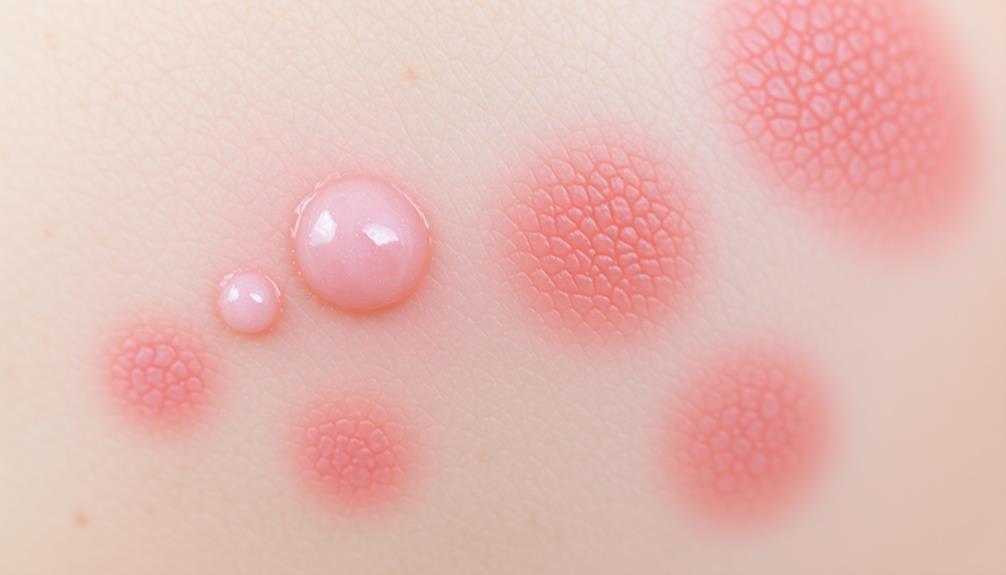Herpes typically looks like small red or white bumps that can develop into fluid-filled blisters. You might notice these on your genitals or around your mouth, depending on whether it's genital or oral herpes. During the initial outbreak, these blisters may break open and become painful sores, often appearing yellowish. As they heal, crusts form, changing color from dark to brown. Recurrences of herpes usually show similar symptoms but are often less severe. Recognizing these signs early can help you manage the condition effectively. There's more to understand about herpes and its treatment options waiting for you.
Key Takeaways
- Initial symptoms may include small red or white bumps on the skin, signaling the onset of herpes.
- Blistering occurs with fluid-filled sores that can break open and may appear yellow to white.
- Healing involves crust formation over sores, which transition from darkening to brown as they recover.
- Genital herpes typically presents blistery sores on the penis, vulva, or anus, accompanied by itching and burning sensations.
- Oral herpes appears as cold sores or fever blisters around the mouth, usually lasting a few weeks and often triggered by stress or illness.
Understanding Herpes Types

Understanding the complexities of herpes types can help demystify this common condition. The herpes simplex virus (HSV) has two primary types: HSV-1 and HSV-2. You might associate HSV-1 with oral herpes, as it typically causes cold sores or fever blisters around the mouth.
On the other hand, HSV-2 is primarily linked to genital herpes symptoms, often presenting as itchy or painful blisters in the genital area.
Both types can lead to lifelong infections, with symptoms that can vary considerably in severity and frequency. It's crucial to recognize that transmission occurs through direct skin-to-skin contact, which includes sexual activity. This means you can contract the virus even when no visible symptoms are present.
According to the World Health Organization, around 67% of the global population has HSV-1, while approximately 11% are affected by HSV-2.
Understanding these types helps you recognize the potential risks and manage your health better. By being informed, you can take steps to prevent transmission, whether you're dealing with oral or genital herpes, ensuring a more informed approach to your sexual health.
Visual Symptoms of Herpes
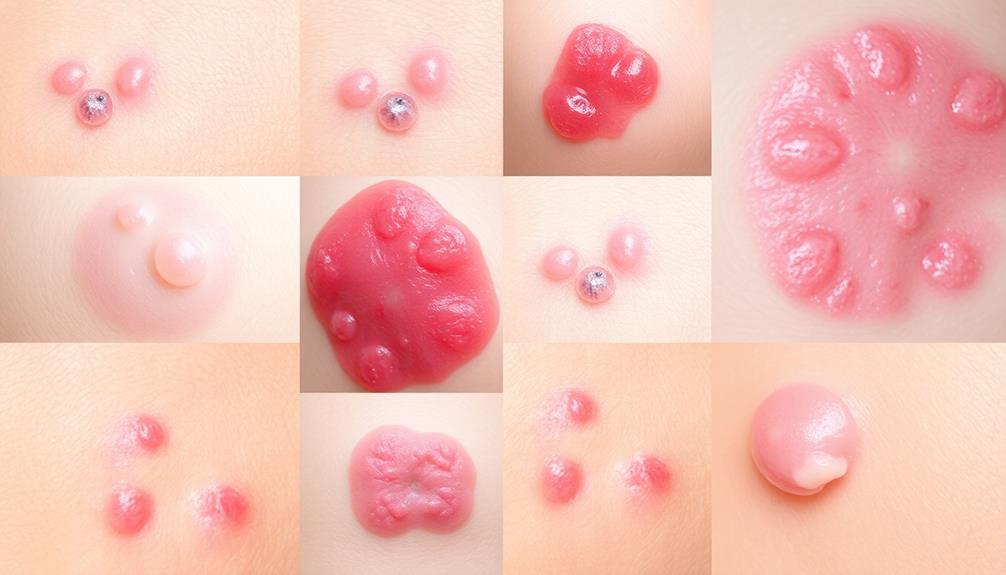
Herpes symptoms often manifest visually as fluid-filled blisters that can be painful and alarming. Initially, you might notice tingling, itching, or burning sensations around the affected area before the blisters appear. These blisters can vary in size and often cluster together, forming painful sores on the genitals or mouth.
Here's a quick overview of the visual symptoms you may experience:
| Stage | Description | Color Range |
|---|---|---|
| Initial | Small red or white bumps may appear | Red to white |
| Blistering | Fluid-filled blisters that may break open | Yellow to white |
| Healing | Crusts form as the sores begin to heal | Darkening to brown |
The color of herpes sores can change as they progress, moving from red to yellow or white before healing. Recurrences often present similar visual symptoms, but they're typically less severe and heal more quickly than the initial outbreak. Understanding these visual symptoms can help you identify herpes and seek appropriate care.
Genital Herpes Characteristics
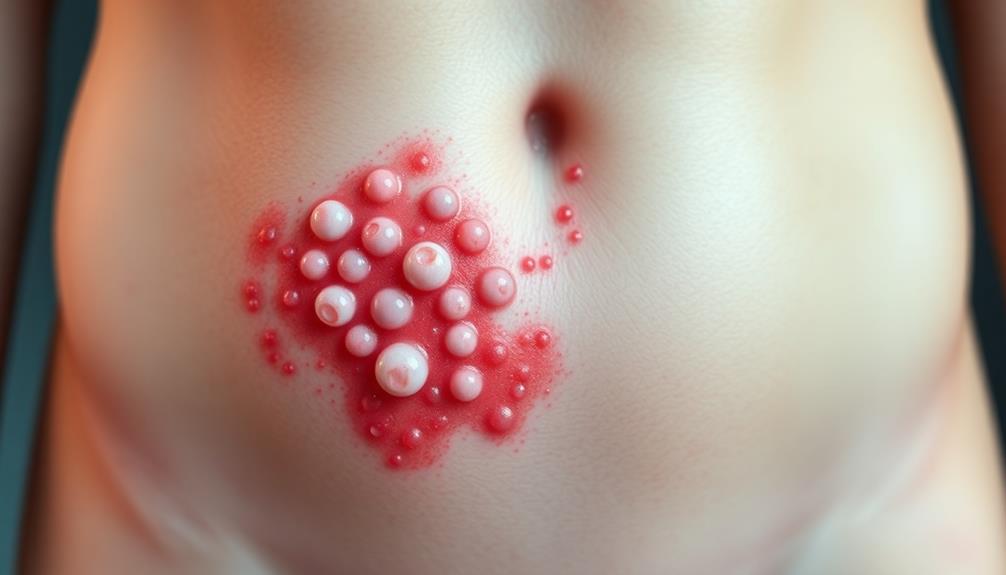
When you first experience genital herpes, you might notice itchy or painful blisters appearing within a couple of weeks after exposure.
These sores can be accompanied by symptoms like burning during urination and flu-like feelings.
As the outbreak progresses, the blisters may break open and eventually crust over, healing in a few weeks, but recurrences are common in the first year.
Initial Outbreak Symptoms
Typically, the initial outbreak of genital herpes can occur anywhere from 2 to 20 days after exposure to the virus. During this time, you might notice some early symptoms like tingling, itching, or burning sensations around the genital area. These initial herpes symptoms can be quite uncomfortable and often signal that the herpes simplex virus (HSV) is making its presence known.
As the first outbreak progresses, you may develop small painful blisters filled with fluid, which often cluster on the genitals, buttocks, or thighs. These blisters can rupture and form sores, which may take some time to heal.
Accompanying these symptoms, you might also experience flu-like symptoms, such as fever, swollen lymph nodes, and body aches, making this initial phase particularly challenging.
The initial outbreak usually lasts anywhere from 2 to 4 weeks, and while sores heal faster for some, others may find it takes longer.
It's essential to recognize that many people may have few or even no symptoms during the first outbreak, allowing the infection to go unnoticed and potentially spread to others.
Recurrence and Healing Process
Recurrence of genital herpes often brings a mix of anxiety and uncertainty, as many individuals navigate the cycle of outbreaks. During these recurrences, you might notice clusters of itchy or painful blisters that can ooze and lead to ulcers. Understanding the healing process can help you manage these outbreaks more effectively.
- Initial outbreaks are typically more severe, lasting 2-4 weeks, while recurrences are shorter and usually heal within 7-10 days.
- The symptoms of recurrences tend to be less intense, often resulting in a quicker recovery.
- Prescription antiviral medications can greatly reduce both the duration and severity of your symptoms.
As you continue to experience outbreaks, you may find that their frequency and intensity decrease over time, especially after the first year of infection.
Over time, you can expect the healing process to become smoother, making each episode more manageable. Staying informed and utilizing antiviral treatments can help you navigate the challenges of genital herpes with greater confidence.
Oral Herpes Appearance
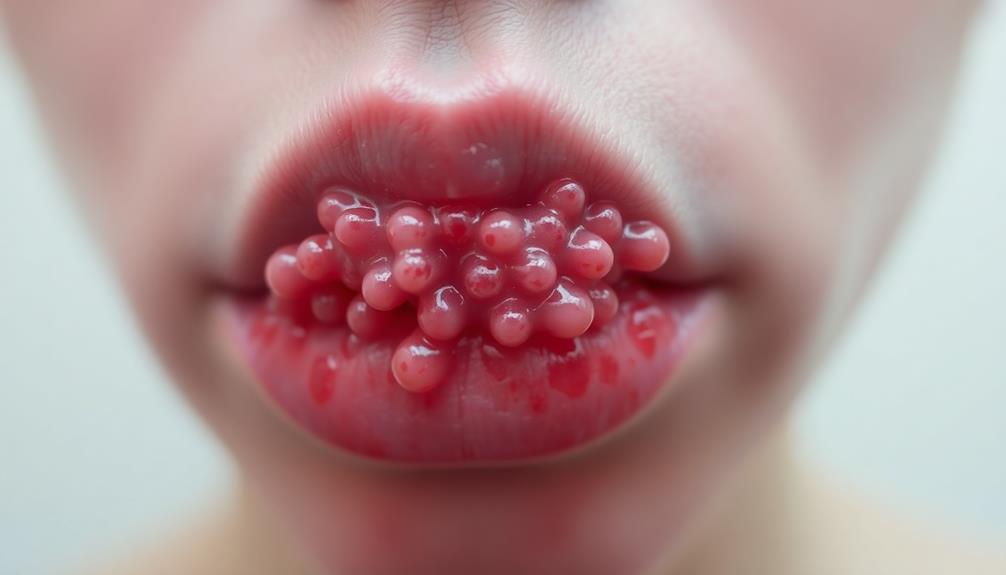
Oral herpes often manifests as cold sores or fever blisters around your mouth, appearing as fluid-filled blisters on your lips or the surrounding facial areas.
During initial outbreaks, you might notice sores inside your mouth, which can be more painful than those on the outside. These fluid-filled blisters typically develop after you experience tingling or itching sensations, signaling the onset of symptoms.
Cold sores usually last for a few weeks before they heal completely. While they might be uncomfortable, they're generally harmless for adults.
However, keep in mind that cold sores can recur over time, often triggered by factors like stress, illness, or sun exposure. When they do return, they're generally less painful than genital herpes outbreaks.
It's important to be cautious, as cold sores can pose severe complications if transmitted to newborns during delivery or through close contact.
If you notice any signs of oral herpes, such as cold sores or fever blisters, consider consulting a healthcare professional for guidance on managing your symptoms and preventing transmission.
Symptoms in Men and Women
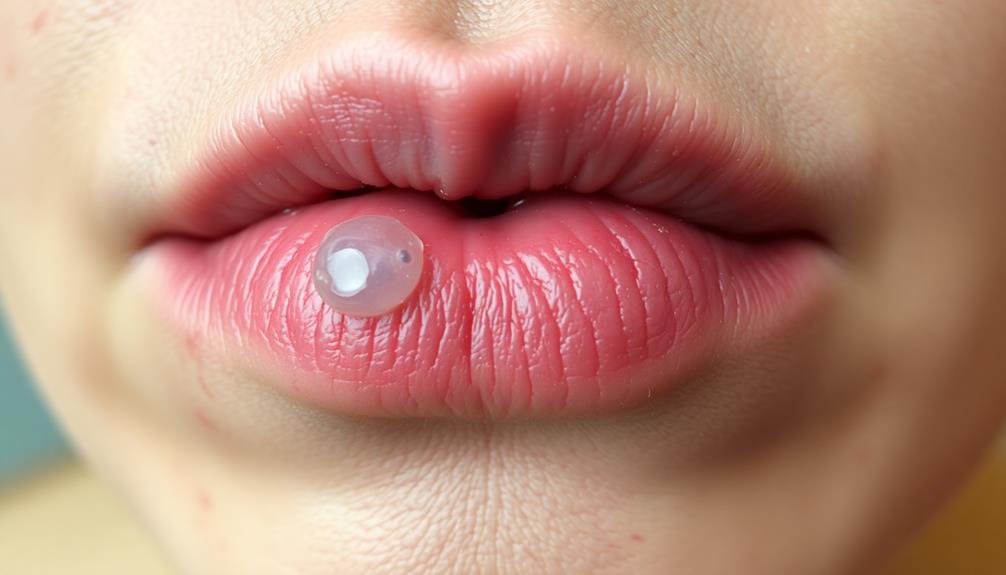
When it comes to herpes symptoms, men and women can experience some notable differences.
You might notice blistery sores in men on the penis or anus, while women may see them on the vulva or cervix.
Both genders can also face burning during urination and other flu-like symptoms, making it essential to recognize these signs early.
Symptoms in Men
Men often experience distinct symptoms when infected with genital herpes, which can include blistery sores on the penis or anus.
These blisters filled with fluid can create discomfort and may break, leading to sores around the genitals that can ooze or bleed. During this time, you might also notice some initial symptoms that resemble flu-like signs.
Here are three common symptoms to watch for:
- Painful blisters: These can develop on your genitals or surrounding areas, causing significant discomfort.
- Burning sensation: You may feel a burning sensation while urinating, making it painful to relieve yourself.
- Swollen glands: Initial symptoms can also include swollen glands, fever, chills, and headaches, typically occurring 2-12 days after exposure to the herpes simplex virus.
It's essential to recognize that some men might've mild or unnoticed symptoms, which can make it easier to transmit the virus unknowingly.
For proper diagnosis, a medical evaluation is vital; this may involve visual inspection and laboratory testing to confirm the herpes simplex virus infection.
Don't hesitate to seek help if you suspect you have symptoms.
Symptoms in Women
Women can experience symptoms of genital herpes that may be similar to those seen in men, but there are notable differences. You might notice blistery sores appearing on the vulva, cervix, or anus. These sores can sometimes be mild and go unnoticed, making it essential to pay attention to any unusual changes.
Along with these sores, you could experience genital pain and burning during urination.
During the initial outbreak, which usually occurs 2-20 days after exposure to the herpes simplex virus, you might also have flu-like symptoms like fever and swollen glands. This outbreak typically lasts 2-4 weeks, but subsequent recurrences tend to be shorter and less severe.
It's important to note that you may experience itching and discomfort in the affected areas, which can complicate recognizing herpes symptoms as they might resemble other conditions.
To confirm whether you have genital herpes, a medical evaluation is necessary. This may involve a visual inspection or laboratory testing to check for the presence of the herpes simplex virus. Taking prompt action can help you manage the symptoms effectively.
Newborn Herpes Symptoms
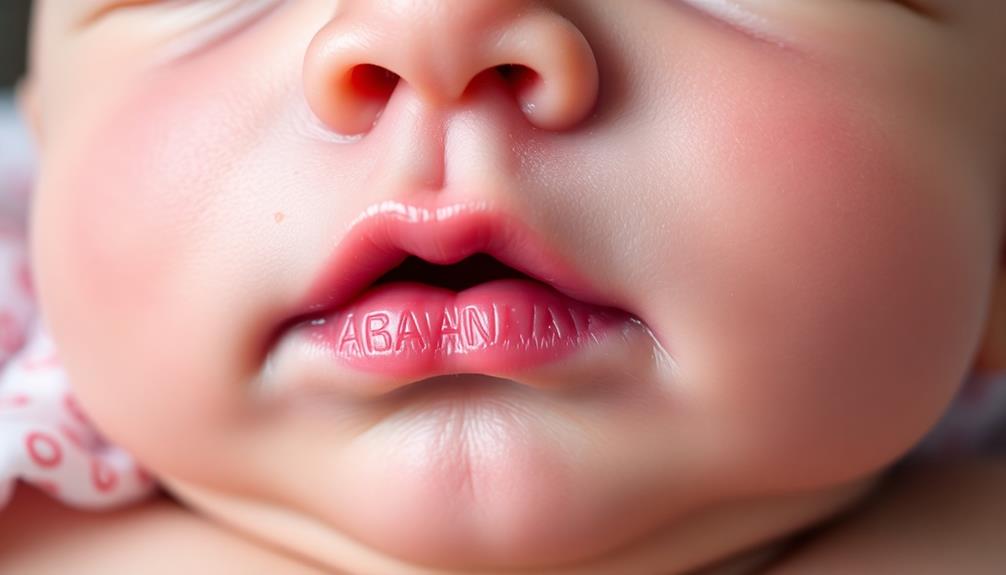
Newborn herpes can be alarming, as it often presents with severe symptoms that require immediate attention. You should be aware of the signs, especially since symptoms typically surface 5-9 days after exposure to the herpes simplex virus during birth.
Early diagnosis is vital for effective treatment and better outcomes. Watch for these key symptoms:
- High Fever: A sudden increase in body temperature can indicate a serious infection.
- Irritability and Poor Feeding: If your newborn seems unusually fussy or refuses to eat, it could be a sign of distress.
- Localized Lesions: Look for any blisters or sores on the skin, which may appear in clusters and are often painful.
In some cases, seizures may occur, signaling a life-threatening condition that needs immediate medical intervention.
If you notice any of these symptoms in your newborn, don't hesitate to seek medical help. Early detection and treatment can greatly improve the situation, so staying vigilant and informed is essential for every parent.
Complications of Herpes

Herpes can lead to serious complications that you should be aware of.
For instance, the virus can increase your risk of contracting other STIs due to open sores, and it may also cause severe eye infections if it spreads to the eyes.
These complications highlight the importance of managing herpes effectively to protect your health.
Severe Eye Infections
Severe eye infections can be a distressing complication of herpes, particularly in the form of herpes keratitis. This condition often arises from the herpes simplex virus (HSV-1) and can lead to troubling symptoms that you shouldn't ignore.
If you experience any of the following, seek medical attention immediately:
- Eye pain: This can range from mild discomfort to severe pain that affects your daily life.
- Light sensitivity: You may find it uncomfortable to be in bright environments, making everyday activities challenging.
- Red swollen eyelids and watery eyes: These symptoms can be quite alarming, signaling that something's wrong.
If left untreated, herpes keratitis can result in vision loss, making prompt diagnosis and treatment essential. Antiviral medications can greatly reduce the risk of complications and help preserve your sight.
Remember, the earlier you address these symptoms, the better your chances of recovery. With an estimated 20,000 to 25,000 cases occurring in the U.S. each year, awareness and timely intervention are critical to combat this serious condition.
Don't hesitate to get help if you suspect herpes keratitis.
Increased STI Risk
Many individuals with genital herpes are unaware that it considerably increases their risk of contracting other sexually transmitted infections (STIs). The presence of sores during a herpes outbreak creates an entry point for pathogens, heightening your susceptibility to infections like HIV. This increased risk is a serious concern, as co-infection rates are significantly higher among those with genital herpes.
| Complication | Description | Medical Attention Needed |
|---|---|---|
| Increased STI Risk | Sores facilitate transmission of infections | Yes |
| HIV Susceptibility | Higher risk of acquiring HIV | Yes |
| Reproductive Health Issues | Complications may lead to infertility | Yes |
| Neonatal Transmission | Herpes can be transmitted to newborns during delivery | Immediate medical attention required |
It's essential to take precautions, as recurrent herpes outbreaks can exacerbate your chances of acquiring or transmitting STIs. Regular screenings and the use of antiviral medicine can help manage your condition. If you're pregnant, be especially vigilant, as transmitting herpes to newborns can be life-threatening and requires immediate medical attention.
Diagnosis and Testing Methods

When you're concerned about possible herpes symptoms, getting an accurate diagnosis is vital. Misdiagnosis is common due to symptoms resembling other conditions like pimples or ingrown hairs.
To guarantee proper identification of the herpes simplex virus, you'll want to take into account these testing methods:
- Swab Tests: These are most effective when taken from active sores. A healthcare professional will collect a sample to confirm the presence of the virus.
- Blood Tests: If you don't have visible sores, a blood test can detect antibodies produced after a previous infection, even if you're asymptomatic.
- Clinical Evaluation: A thorough assessment of your symptoms and medical history by a healthcare provider helps guide the diagnosis and testing process.
Results from these tests usually take a few days, giving you timely information for managing your health.
Treatment Options Available

After receiving a diagnosis, understanding your treatment options for herpes can greatly improve your quality of life. The primary treatments include antiviral medications like acyclovir, famciclovir, and valacyclovir. These drugs help reduce the duration and severity of outbreaks, making them essential for managing your condition.
For symptomatic relief, consider using topical creams that can alleviate pain and discomfort associated with herpes sores.
If you experience frequent outbreaks, your healthcare provider may recommend daily antiviral treatment. This approach not only helps manage symptoms but also reduces the risk of transmission to others.
Regular consultations with healthcare providers are vital for developing personalized treatment plans. They can help you make necessary adjustments based on the frequency and severity of your outbreaks.
Additionally, adopting lifestyle changes such as stress management and effective hygiene management can support your overall treatment strategy.
Preventative Measures and Awareness
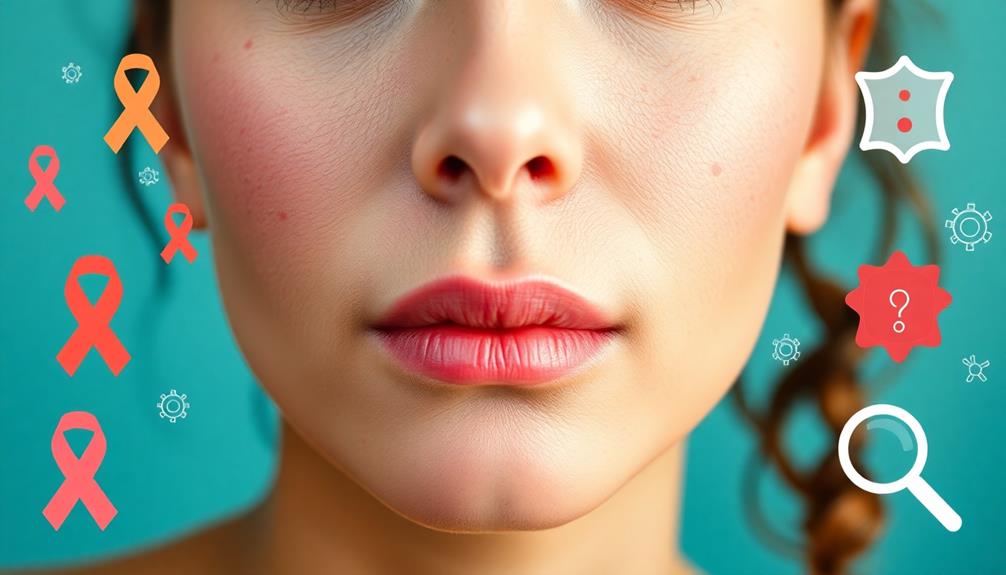
Preventing the spread of herpes involves a combination of proactive measures and awareness. By taking these steps, you can considerably reduce the risk of transmission and protect your health.
- Use condoms or dental dams: These barriers are vital during sexual activity, as they can greatly minimize the chances of passing on herpes and other STIs.
- Communicate openly with partners: Regular STI screenings and honest discussions about your sexual health are essential. This education builds awareness and helps you both make informed decisions.
- Recognize personal triggers: Being aware of what causes your outbreaks, like stress or illness, can help you manage symptoms effectively. Avoiding sexual contact during active outbreaks—no matter how mild—will keep your partner safe.
The World Health Organization reports that about 67% of the global population has oral herpes (HSV-1), underscoring the importance of public awareness.
Frequently Asked Questions
What Does Herpes Look Like When It Starts?
When herpes starts, you might feel tingling or itching in the area. Small bumps may appear, quickly turning into fluid-filled blisters. These clusters can be painful and typically last a few weeks before healing.
How Do You Know Exactly if You Have Herpes?
Did you know that nearly 1 in 6 people in the U.S. have genital herpes? If you suspect you might have it, look for symptoms like itching or blisters, and consult a healthcare professional for testing.
What Are 5 Symptoms of Herpes?
You might notice symptoms like painful blisters in the genital area, itching or tingling sensations, burning during urination, flu-like signs, and swollen glands during the initial outbreak. Be aware of these signs for better understanding.
How Do You First Notice Herpes?
When it rains, it pours. You might first notice herpes through tingling or itching sensations, often followed by painful blisters. Flu-like symptoms can also pop up, making it essential to stay alert after exposure.
Conclusion
So, there you have it—herpes in all its glorious forms! Whether it's throwing a party on your genitals or making a surprise appearance on your lips, this viral guest loves to crash uninvited. Remember, knowing the signs can help you dodge this pesky party crasher. Stay informed, stay safe, and for goodness' sake, keep your lips and other areas to yourself unless you're ready to share more than just a kiss!

